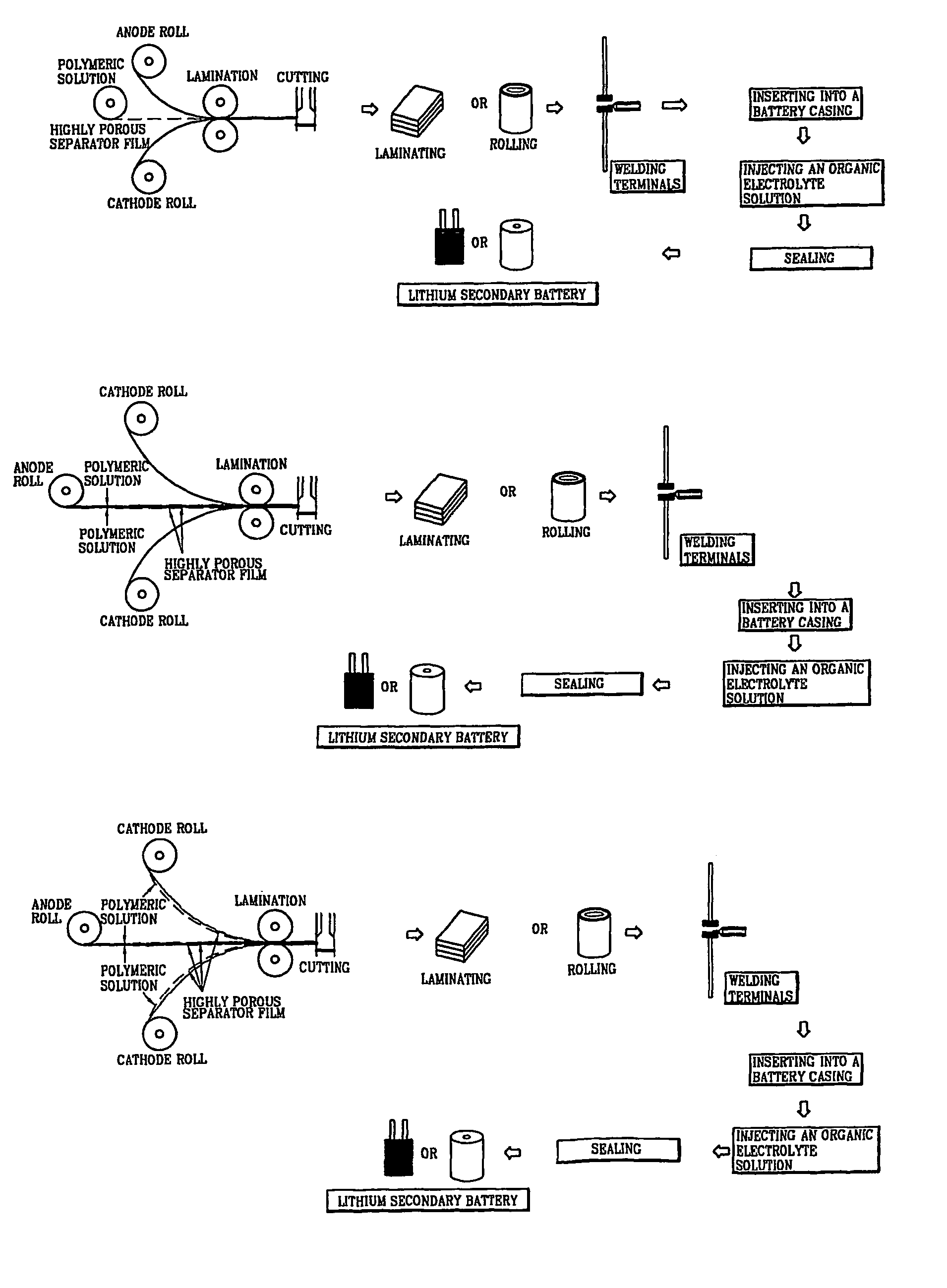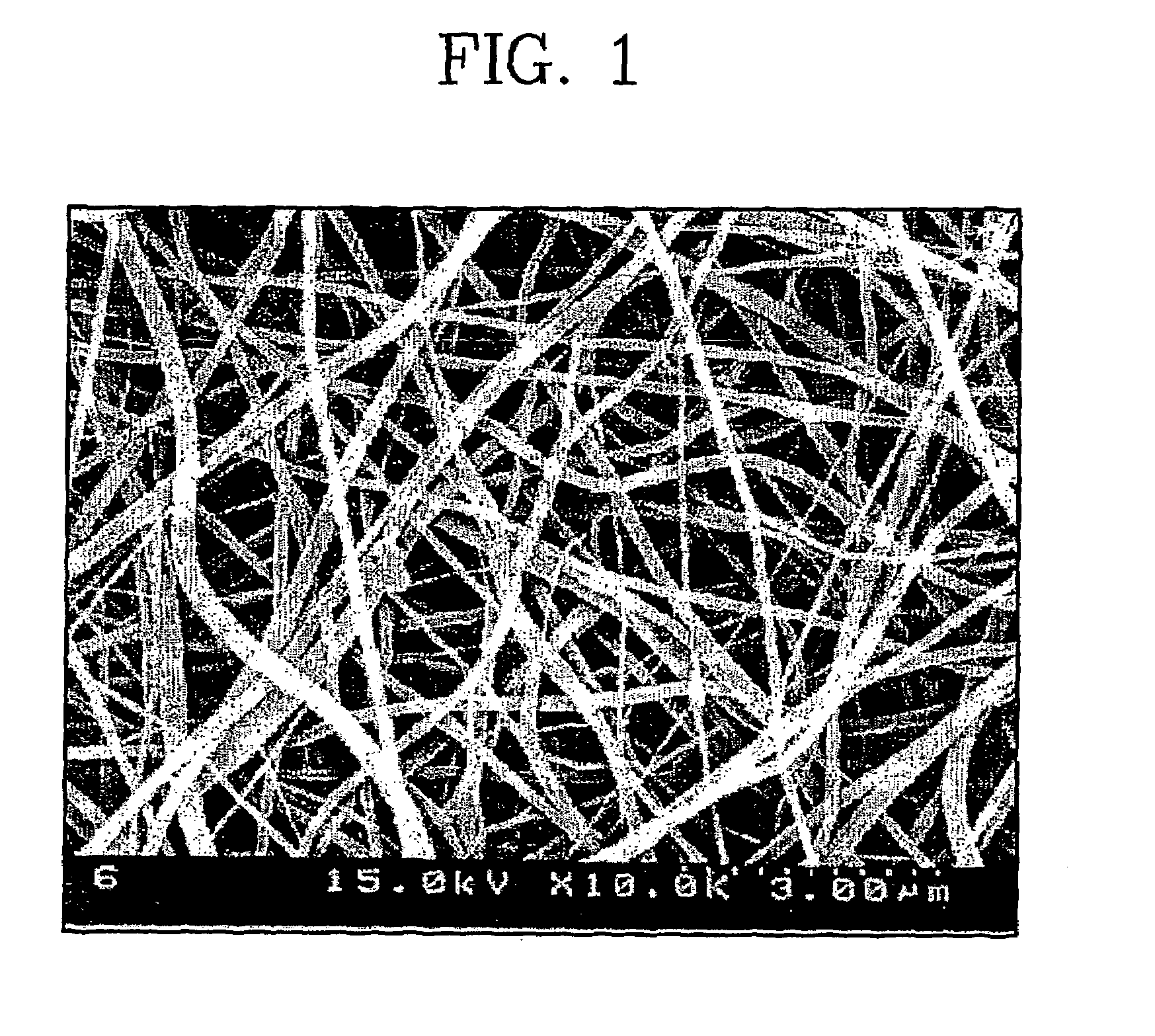Lithium secondary battery comprising a super fine fibrous polymer separator film and its fabrication method
a technology of fibrous polymer separator and secondary battery, which is applied in the direction of wound/folded electrode electrodes, cell components, sustainable manufacturing/processing, etc., can solve the problems of battery instability, limited high capacity, and restriction of battery shape, so as to improve the adhesion of electrodes, mechanical strength, and the effect of good adhesion
- Summary
- Abstract
- Description
- Claims
- Application Information
AI Technical Summary
Benefits of technology
Problems solved by technology
Method used
Image
Examples
example 1
[0037]1-1) Fabrication of a Porous Polymer Separator Film
[0038]20 g of polyvinylidenefluoride (Kynar 761) was added to 100 g of dimethylacetamide, and the resulting mixture was stirred at room temperature for 24 hours to give a clear polymeric solution. The resulting polymeric solution was filled into a barrel of an electrospinning apparatus and discharged onto a metal plate at a constant rate using a nozzle charged with 9 kV to fabricate a porous polymer separator film having a thickness of 50 μm.
[0039]1-2) Fabrication of a Lithium Secondary Battery
[0040]The porous polymer separator film fabricated in Example 1-1 was inserted between a graphite anode and a LiCoO2 cathode, the resulting plates were cut so as to be 3 cm×4 cm in size and laminated. Terminals were welded on the electrodes and the laminated plate was inserted into a vacuum casing. A 1M LiPF6 solution in EC-DMC was injected into the vacuum casing, and then finally the vacuum casing was vacuum-sealed to fabricate a lithiu...
example 2
[0041]2-1) 20 g of polyvinylidenefluoride (Kynar 761) was added to 10 g of dimethylacetamide, and the resulting mixture was stirred at room temperature for 24 hours to give a clear polymeric solution. The resulting polymeric solution was filled into the barrel of an electrospinning apparatus and discharged onto both sides of a graphite anode at a constant rate using a nozzle charged with 9 kV to fabricate a graphite anode coated with a porous polymer separator film having a thickness of 50 μm.
[0042]2-2) A LiCoO2 cathode was adhered onto the porous polymer separator film obtained in Example 2-1. The resulting plate was cut so as to be 3 cm×4 cm in size and laminated. Terminals were welded on the electrodes and the laminated plate was inserted into a vacuum casing. A 1M LiPF6 solution in EC-DMC was injected into the vacuum casing, and the casing was then finally vacuum-sealed to fabricate a lithium secondary battery.
example 3
[0043]3-1) 20 g of polyvinylidenefluoride (Kynar 761) was added to 100 g of dimethylacetamide, and the mixture was stirred at room temperature for 24 hours to give a clear polymeric solution. The resulting polymeric solution was filled into the barrel of an electrospinning apparatus and discharged onto one side of a LiCoO2 cathode at a constant rate using a nozzle charged with 9 kV to fabricate a LiCoO2 cathode coated with a porous polymer separator film having a thickness of 50 μm.
[0044]3-2) The LiCoO2 cathode obtained in Example 3-1 was adhered onto both sides of the graphite anode obtained in Example 2-1 so as to face the porous polymer separator films to each other. The resulting plate was made into one body by heat lamination at 110° C., followed by cutting so as to be 3 cm×4 cm in size and then laminated. Terminals were welded on the electrodes and then the laminated plate was inserted into a vacuum casing. A 1M LiPF6 solution in EC-DMC was injected into the casing, and the ca...
PUM
| Property | Measurement | Unit |
|---|---|---|
| Diameter | aaaaa | aaaaa |
| Nanoscale particle size | aaaaa | aaaaa |
Abstract
Description
Claims
Application Information
 Login to View More
Login to View More - R&D
- Intellectual Property
- Life Sciences
- Materials
- Tech Scout
- Unparalleled Data Quality
- Higher Quality Content
- 60% Fewer Hallucinations
Browse by: Latest US Patents, China's latest patents, Technical Efficacy Thesaurus, Application Domain, Technology Topic, Popular Technical Reports.
© 2025 PatSnap. All rights reserved.Legal|Privacy policy|Modern Slavery Act Transparency Statement|Sitemap|About US| Contact US: help@patsnap.com



